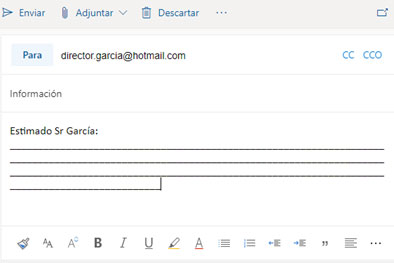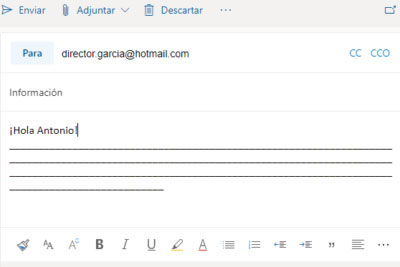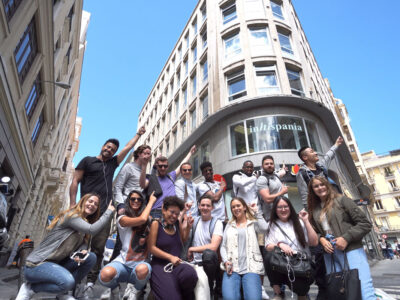Surely now that you have started learning Spanish, you have had to face new situations. One of your new language challenges may have been having to write a formal email to your landlord or to a company to apply for a job. A task that seems extremely complicated if you don’t have the right linguistic resources. Don’t worry, don’t panic! In this post, you’ll find good tips that can save you when writing a formal email in Spanish.
… For our task, we need to be clear about the differences between a formal letter and an informal one. A priori there aren’t as many as it might seem at first, but even if they are few, you should know them well to avoid mistakes in either style. Below, we’ll look in detail at the main differences between a formal and an informal email:
1. The Greeting
This difference is one of the most obvious, because formal emails use courtesy differently. For example:
Formal greetings:
- Dear + Mr. (man) + (surname)/ Mrs. (woman) + (surname):
This form is timeless, meaning you can use it at any time of day. Instead of the first name, you can also use the recipient’s surname; if you choose this option, you must put Mr. (man) or Mrs. (woman) before it, for example: Dear Mr. García.
- Dear + (position or profession) / Mrs. (position or profession)
The position is the person’s job or the post they hold at work, for example: Dear Professor.
When you don’t know who you are addressing, whether a man or a woman, you can use the formal greeting “Dear Sirs,” which can help you out of any predicament.
- Distinguished + Mr. (Sr.), Mrs. (Sra.)
+ Mr. (Sr.) + Surname, Mrs. (Sra.) + Surname
Position or profession

Informal greetings:
- Hi + (name)!
- Good morning (until 12:00 p.m.) + (recipient’s name), e.g.: Good morning, María.
- Good afternoon (from 1:00 p.m.) + (recipient’s name), e.g.: Good afternoon, Juan.
- Good evening (from 8:00 p.m.) + (recipient’s name), e.g.: Good evening, Marta.
- Dear + (name)
- Hey + (name)!

2. The Form of Address
Formal emails must be written using the “usted” form, while in informal emails you can use “tú.” This is because, with the person you’re writing a formal message to, you don’t share any personal relationship, so you must remain polite and use “usted.” In contrast, you have a closer relationship with the recipient of an informal message.
Formal: use of “usted.” Example: I am writing to you, Mr. García, to tell you about a problem that occurred in today’s class.
Informal: use of “tú.” Example: Juan, I want to tell you that there was a problem in class today.
3. Introduction to the Topic
… The introduction to the topic or subject of formal emails, as with letters, is shorter compared to informal ones. The main reason is that in a formal email we usually include a brief introduction so the recipient knows who we are and why we are writing. In contrast, the informal email is conversational and open, just like a real conversation.
Formal: short introduction and clear structure. Example:
- My name is _____Juan García_____ and I am writing to you because I would like your advice about the academy’s Spanish courses. […]
- I am ______Juan García________ and I am writing to you to find information about the academy’s Spanish courses. […]
Informal: open introduction and structure. Example: How are you, María? I hope you’re well. I wanted to ask you about what you told me the other day, I don’t know if you remember. How are the academy’s courses? […]
4. The Body of the Message
In this part of the email, we must remember the courtesy form we are using. Emails allow us to write a bit more compared to traditional letters. However, even in a letter, we shouldn’t go overboard with the message. In contrast, with informal emails or letters, we have complete freedom to write as much as we want.
Formal: we shouldn’t exceed the number of paragraphs.
Informal: we have total freedom with the number of paragraphs.
Besides paying attention to paragraphs, we must also remember the formality when writing our message. In Spanish, the formal style is used for: requesting information, making a claim, making a complaint, etc. One of the most common mistakes when writing these types of letters is using informal structures. Here are some examples:
- Give me information please > Could you give me information/ I would like you to give me information
- You have to fix it please > Please, you must fix it/ Please, you have to fix it because it’s in the contract.
- Contact me as soon as possible > I kindly ask you to contact me as soon as possible
Note: Don’t be fooled, using “please” does not make something formal.
5. The Closing
… Once you’ve finished the body of your formal message, one of your last steps is to close your email. In Spanish, we have various structures that can help you:
- In summary, after everything mentioned, I would like…
- In conclusion, after everything mentioned, I kindly ask that you…
- According to what has been said above, I hope you can…
- For all the above, it would be advisable that…
You can also use these forms in informal messages, but with some variations:
- In summary, after everything I’ve told you, I would like…
- In conclusion, after everything I’ve told you, I kindly ask that you…
- Regarding everything I’ve told you before, I hope you all can…
- For everything I’ve mentioned, I think it would be preferable that…
… Finally, formal emails and letters require a polite closing with the appropriate courtesy formulas. This is not the case with informal ones, as each person says goodbye differently depending on their relationship with the recipient. These are the most used forms in Spanish:
- Thank you in advance. Kind regards. María Gómez
- Awaiting your reply. Kind regards. Juan Pérez.
- Kind regards. Marta Fernández.
In contrast, in informal emails and letters we have more freedom; it all depends on how close we are to the recipient. This is up to each person.
- Thanks a lot, María. A kiss/ hug.
- Keep me posted. A hug/ hug. Juan.
| Differences between a formal and an informal email | |
| Formal | Informal |
Formal greetings:
|
Informal greetings:
|
| Formal address (“usted”) | Informal address (“tú”) |
Formal introduction:
|
Informal introduction:
|
Formal body:
|
Informal body:
|
| Formal closings:
1st Part (to start closing the message)
2nd Part (to close the message)
|
Informal closings:
1st Part (to start closing the message)
2nd Part (to close the message)
|
3. Regards, Marta.
Remember that emails or letters are distinguished by two main points.
Here is a table that summarizes them for you:
| Formal closings: | Informal closings: |
1st Part (to start closing the message)
|
1st Part (to start closing the message)
|
2nd Part (to close the message)
|
2nd Part (to close the message)
|
If you pay close attention to the differences between formal and informal emails regarding greetings, form of address, introduction to the topic, body of the message, and closing, it will be easy for you to adapt your written communications according to the needs of each moment. Of course, you can learn and copy the expressions and phrases from this post, adapting them to each specific situation. Keep in mind that, given the friendliness and closeness of Spanish culture, sometimes there isn’t a clear rule to know which style to use, formal or informal, for example, if you contact the school where you study Spanish. In our case, we always prefer that you write us an informal email-unless you want to practice what you’ve just learned in this post! 😉



